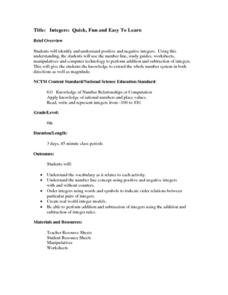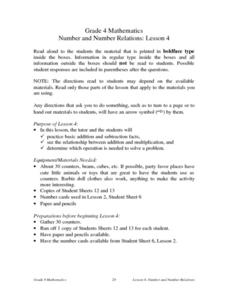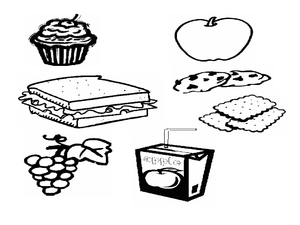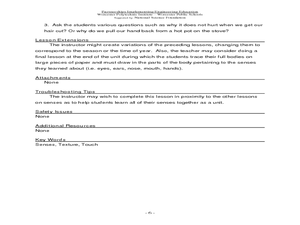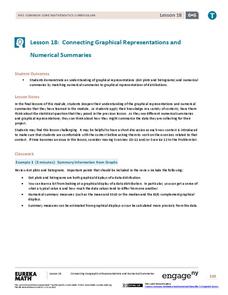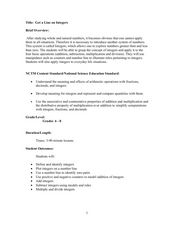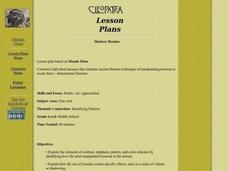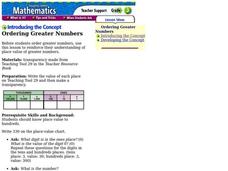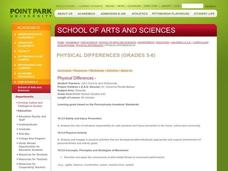National Security Agency
Integers: Quick, Fun and Easy To Learn
A good complement to any integers unit contains a three-day lesson plan about positive and negative integers, adding and subtracting integers, and how to find the additive inverse. Additionally, it provides all necessary...
Curated OER
Number and Number Relations: Lesson 4
Fourth graders investigate the use of addition and subtraction facts in different situations. They examine the relationship between addition and multiplication and determine which operation is needed to solve various problematic situations.
Curated OER
The Five Senses
Students use their senses to identify a variety of items in mystery boxes after listening to a read aloud of Aliki's, "My Five Senses." They taste and smell items to identify them before completing a Senses Literature Log. They label the...
Curated OER
Engineering and the Senses: Smell
Pupils define the sense of smell. For this smell sense lesson, students review their five senses and define the importance of smell. Pupils practice smelling and identifying items in bags. Students discuss the importance of smell to...
Curated OER
Engineering and the Senses
Students explore nutrition. In this nutrition lesson, students discuss a person's sense of taste and how it is different for each person. Students discuss favorite foods and how they relate to nutrition. Students cut out pictures of...
Curated OER
Sense of Taste
Students swab different sections of the tongue to identify taste buds. In this sense of taste instructional activity, students make predictions and conduct an experiment. Students experiment with a variety of flavors and...
Curated OER
Engineering the Senses
Students become aware of texture and the sense of touch. In this senses activity, students become aware of their dominant hand. Students draw pictures using texture. Students describe a texture of an item in a mystery bag.
Curated OER
Agriculture Counts
Students practice counting. In this early numbers lesson, students learn about the beginnings of agriculture and how it ties into math. Students practice counting objects related to agriculture.
Curated OER
Number Line Locomotion
Here is a great lesson that incorporates movement into academic learning. Students improve addition subtraction skills by using number lines and locomotor movement.
Inside Mathematics
Expressions
Strive to think outside of the quadrilateral parallelogram. Worksheet includes two problems applying prior knowledge of area and perimeter to parallelograms and trapezoids. The focus is on finding and utilizing the proper formula and...
Noyce Foundation
Time to Get Clean
It's assessment time! Determine your young mathematicians' understanding of elapsed time with this brief, five-question quiz.
EngageNY
Connecting Graphical Representations and Numerical Summaries
Which graph belongs to which summary statistics? Class members build upon their knowledge of data displays and numerical summaries to connect the two. Pupils make connections between different graphical displays of the same data in...
Curated OER
Egyptian Fractions
You don't have to be an ancient Egyptian to decipher fractions in this activity that focuses on adding fractions with unlike denominators and developing fraction number sense. Egyptians represented fractions differently than we do. They...
Attainment Company
Money Skills
Young mathematicians learn to make sense out of money with this collection of skills practice worksheets. From identifying the different coins and bills in the US currency system, to counting money and correctly using the dollar and...
Curated OER
Get a Line on Integers
Students explore number sense by completing math function problems in class. In this integers lesson, students define integers and practice plotting them on a number line. Students utilize math functions such as addition and...
Education Development Center
Making Sense of Unusual Results
Collaboration is the key for this equation-solving lesson. Learners solve a multi-step linear equation that requires using the distributive property. Within collaborative groups, scholars discuss multiple methods and troubleshoot mistakes.
EngageNY
Percent of a Quantity
Visualize methods of finding percents. Classmates find a percent of a quantity using two methods including a visual model in the 26th lesson in a series of 29. By the end of the lesson, scholars find percents given a part and the whole...
Curated OER
The Battle for Ultimate Power
Students gain an understanding of how the powers of 10 and scientific notation can be used to represent the scale of things in the universe. They relate the number of stars in the universe to the number of grains of sand on Earth's beaches.
Curated OER
Modern Mosaics (Grades 6-8)
Students explore the elements of contrast, emphasis, pattern, and color schemes by identifying how the artist manipulated tesserae in the mosaic. They create original mosaics by manipulating torn paper to depict different textures and...
Curated OER
Vocab. Quiz: Grade Two (Grade 2) Vocabulary List Two
In this second grade vocabulary worksheet, 2nd graders match the 15 terms in the left-hand column to the appropriate definitions in the right-hand column.
Curated OER
Ordering Greater Numbers
Third graders identify the place value of greater numbers. In this number sense lesson, 3rd graders use a place value chart to properly write a specific number. Students read the number and use the place value map for reinforcement.
Curated OER
I'm Special
Students explore their five senses and what makes them special and unique. They listen to books about their senses and participate in a taste and smell experiment. Students also create a senses journal, and create an "I'm Special" book...
Curated OER
Diversity
Students access prior knowledge of the five senses and relate to students with disabilities. In this people with disabilities lesson, students research and use a Venn diagram to compare and contrast famous people and their...
Curated OER
Divisibility Rules Using Scientific Calculators
Young learners apply divisibility rules to determine if a number is a factor of another number. They discuss what numbers are factors of another number and identify patterns using divisibility rules.
